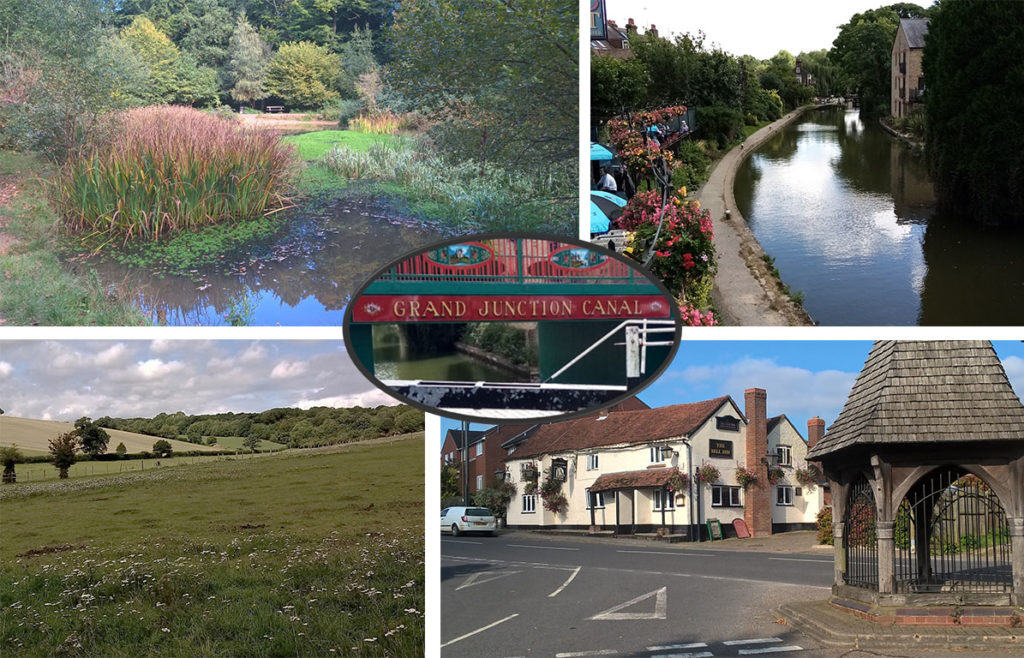
Distance: 15.4 miles
Start/finish: Tring railway station, Station Road. Pay car park. NB The station is about a mile from the centre of the town: Kings Langley station, Station Road. Pay car park.
Map: Ordnance Survey Explorer map 182 and 181.
Public transport: Stations at Tring, Hemel Hempstead and King’s Langley are on the same London Northwestern line. Arriva runs the 500 bus service which links Tring (some way from the station and the start of the walk), Hemel Hempstead and King’s Langley. Check timetables on the web londonnorthwesternrailway.co.uk arrivabus.co.uk/herts-and-essex
Pubs/refreshments:
*The Halfway House is off route.
Please make sure you check with the pub/restaurant for their opening times.
If you followed the route outlined in the guidebook through Chipperfield Common you will have to turn left and walk back into the village when you reach the road. None of the pubs are directly on the recommended path. Of course if you make your own way through the common and its 116 acres with an eye for a drink and a rest it’s highly likely you’ll emerge near these three outlets.
NB: This is the longest leg at just over 15 miles. As it is arguably the prettiest and most varied stretch I decided to enjoy the delights of such sublime walking by taking it easy and stopping at Bovingdon after ten miles. It was a beautiful summer day and it seemed the journey demanded my attention and to simply “knock off” the miles would be a waste. It was the right decision. The Friends of the Hertfordshire Way’s official guidebook suggests possibly dividing the leg into two walks of about nine miles by walking from Tring station to Hemel Hempstead station (the latter part largely following the towpath of the Grand Union Canal) and Hemel Hempstead station to Kings Langley station. However, not having walked them I can only refer you to the guide book which describes the alternatives in detail. The one big advantage if you opt for the shortened walks is that Hemel Hempstead and Kings Langley have good rail and transport links. Bovingdon does not.
Route description: From the minute you leave Tring station you’ll encounter one delight after another. From the Ashridge Estate, to Berkhamsted Common, historic World War 1 trenches, Berkhamsted Castle, a long pub-rich stretch of the Grand Union Canal towpath, the heavily wooded Chipperfield Common, more kissing gates than you’ll ever open in a day, farmland, pastures and a golf course. Although the Ordnance Survey maps suggest it is a simple, straightforward and easily followed walk there are many twists and turns, route changes come thick and fast and alternatives can cause uncertainty. There’s a lot going on. Although supremely well signposted it may be useful to buy a copy of the guide (and again, I don’t have any interest or financial links with TFHW!!!) as my directions are more “follow the signs and aim for this.” You should never get lost but the guide will be your infallible friend all the way, a friend you can always trust. NOTE: The official route has been, no doubt for common sense reasons, changed in the third edition of the guide. The charming village of Potten End is now bypassed. Instead Berkhamsted, including the castle, is now favoured, including a pleasurable walk along the canal. Having walked both routes I think the revised version is an excellent change.
With your back to Tring Station turn right into Station Road and look for a gap in the hedge on the right which supposedly leads you to a well-trodden unofficial footpath cutting diagonally across the field. But the field had recently been ploughed when I set out and there was no evidence of any obvious route. It looked like a dreary, ankle wrenching slog even if there had been an evident path so I stuck to Station Road. After passing where the Way joins from Stocks Golf Club at the end of the last leg, continue for 50 yards and then drop down into the field on the right where an obvious perimeter path takes you onwards towards a set of telegraph poles. Where the road turns sharp left join the bridleway and continue straight on past the telegraph poles, over a horse gallop, across a road and then start climbing up through a wood. I startled a beautiful roe doe feeding in the dappled sunlight here. She sped off into the woodland and, courtesy of her natural camouflage, was invisible within a second. A charming start to the day. Follow the path until it bears left and comes out at Tom’s Hill House. Identify the path in the woods to the left and take it for nearly 250 yards when it swings right on to a wide path and then after three minutes walking head right on to the Ashridge Estate Boundary Trail. (see pictures below) Watch for the roundels to ensure you aren’t drifting off route. Stick to the right hand side of the woods until the path forks left and almost immediately left again onto an obvious route which, if stuck to, and there’s always a tendency in woodland into being seduced into veering off into a curious but wrong direction, will eventually bring you out at a road. Turn right and walk to the T-junction. Cross over into Berkhamsted Common. It’s been enjoyable so far. Now it gets even better.

 Berkhamsted Common was an historic flashpoint in the fight to protect the public’s access rights to ancient common land.
Berkhamsted Common was an historic flashpoint in the fight to protect the public’s access rights to ancient common land.
The Open Spaces Society – formerly the Commons Preservation Society – had been founded only a year before 24-year-old Lord Brownlow of Ashridge House erected three miles of iron fencing, said to be either five or six feet high, around part of Berkhamsted Common in an attempt to claim 434 acres as part of his estate. He was fearful that new Government legislation would deprive him of common land he regarded as his own. On the night of March 6th, 1866, the Open Spaces Society, Augustus Smith MP and prominent reforming Liberal MP George Shaw-Lefeyre organised a trainload of 120 tough Irish navvies and East End “hard men” to walk from Tring Station to the common to tear down the fence overnight in what became known nationally as the Battle of Berkhamsted Common. Brownlow brought a legal case against Smith for trespass and criminal damage. Sir Robert Hunter (later co-founder of the National Trust in 1895) and the Commons Preservation Society defended the action. Lord Justice Romilly determined that pulling down a fence was no more violent an act than erecting one. He ruled the case rested on the legality of Brownlow’s actions in having put up the fence in the first place and the legal right of the people to use the land. He decided in favour of Smith, a landmark legal decision that resonates to this day. The precedent, along with the Metropolitan Commons Act of 1866, helped ensure the protection of Berkhamsted Common and other commons nationally threatened with enclosure. In 1926 the common was acquired by the National Trust.
The romantic and harmoniously confused lowland woodlands of England generate in many – me included – a sense of well-being and comfort. They’re never oppressively claustrophobic like the dark and sinisterly quiet conifer woods and forests of northern England and elsewhere, many devoid of birdsong. They exude a benign but mysterious spirit, with clustered thickets of fallen branches and seemingly impenetrable shadows inviting exploration and discovery, particularly in those broad-leaved woods that have largely remained unchanged for centuries. Deciduous and mixed woodland is a convivial friend. A plantation of rows of characterless rod straight conifers an easily dismissed passing acquaintance. There can be nothing more uplifting than walking through woodland when a striking shaft of sunlight breaks the canopy to highlight the colours and form of native trees staking their claim amid the leaf litter, bracken, spring bluebells and worn animal tracks.
 The Ashridge estate and beautiful Berkhamsted Common – once part of the estate – have had their ecology shaped by the chalk ridges they sit on. Heavily wooded in parts they nevertheless encourage close inspection as well trodden footpaths and sinuous little tracks lure you into the restless depths. Why is it that so many people feel at ease and secure when wrapped in their ancient embrace? Whenever I enter thick woodland my pace slackens, my senses heighten and there’s a delightful anticipation as to what may unfold.
The Ashridge estate and beautiful Berkhamsted Common – once part of the estate – have had their ecology shaped by the chalk ridges they sit on. Heavily wooded in parts they nevertheless encourage close inspection as well trodden footpaths and sinuous little tracks lure you into the restless depths. Why is it that so many people feel at ease and secure when wrapped in their ancient embrace? Whenever I enter thick woodland my pace slackens, my senses heighten and there’s a delightful anticipation as to what may unfold.
Berkhamsted Common is such a place. Having crossed the tree lined B4506 – at this point the vista is unbroken woodland – follow the bridleway, keeping left when it soon forks, to a gravel track at Little Coldharbour Farm which leads towards Coldharbour Farm. Ignore a bisecting track and continue onwards until you reach a signpost that sends you right en route to Brickkiln Cottage which emerges behind the trees on the right (see picture above).
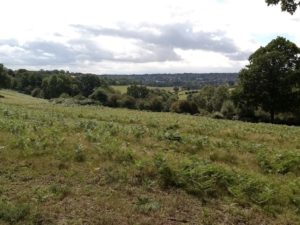 Leaving behind the close confines of the wood follow the broad avenue to a cross roads at the end. The old route to Potten End continues onwards, but you turn right on a waymarked track. Very shortly at another sign turn left and walk slowly uphill towards the restored historic World War l training trenches, with views of Berkhamsted unfolding on your right. (Picture right).
Leaving behind the close confines of the wood follow the broad avenue to a cross roads at the end. The old route to Potten End continues onwards, but you turn right on a waymarked track. Very shortly at another sign turn left and walk slowly uphill towards the restored historic World War l training trenches, with views of Berkhamsted unfolding on your right. (Picture right).
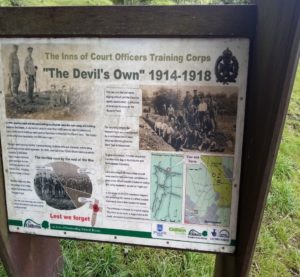
On September 28th, 1914, troops from the Inns of Court Officers’ Training Corps – nicknamed The Devil’s Own – arrived in Berkhamsted to train for fighting in northern France. During four years of the conflict 12,000 troops passed through the tented camp and paraded on what is now called Kitchener’s Field while training on Berkhamsted and Northchurch commons and the surrounding countryside. Nearly eight miles (13 kilometres) of ‘training’ trenches were dug, of which only 500 metres remain. For many of the young men, who won great respect from Berkhamsted’s then 7,500-strong population, it was the last ‘home’ before they left for the Western Front. By 1918 nearly half of all those trainees had become casualties with 2,200 killed.

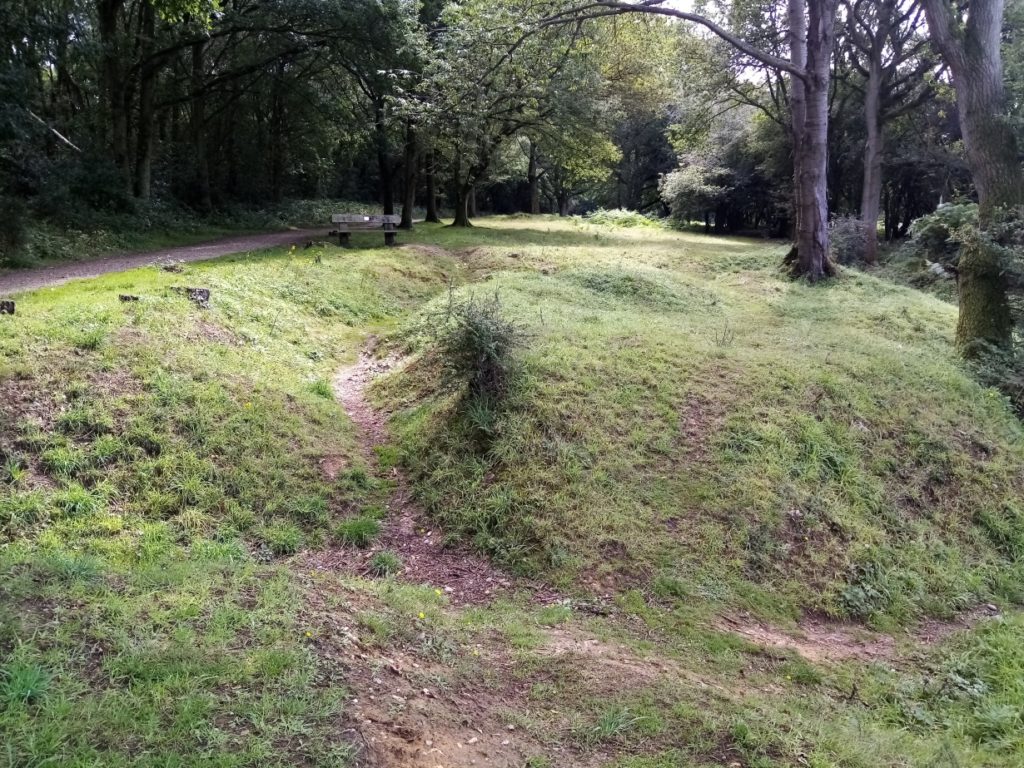
At a junction just after the trenches take the right hand fork and drop down through some woods. Turn right at the next junction, leave the woods and continue down the lane opposite to Well Farm. You are now in a picturesque dry valley. Go through the kissing gate on the left and follow the edge of the field with the hedge on your right. You emerge in Kitchener’s Field with the elegant looking Berkhamsted Cricket Club, founded in 1875, on your right, and then tennis courts and Kitchener’s Bowls Club on the left. Continue into Castle Hill and straight on into Brownlow Road. At the station turn left into White Hill and Berkhamsted Castle. If you want to end the walk now, trains from Berkhamsted stop at Tring.
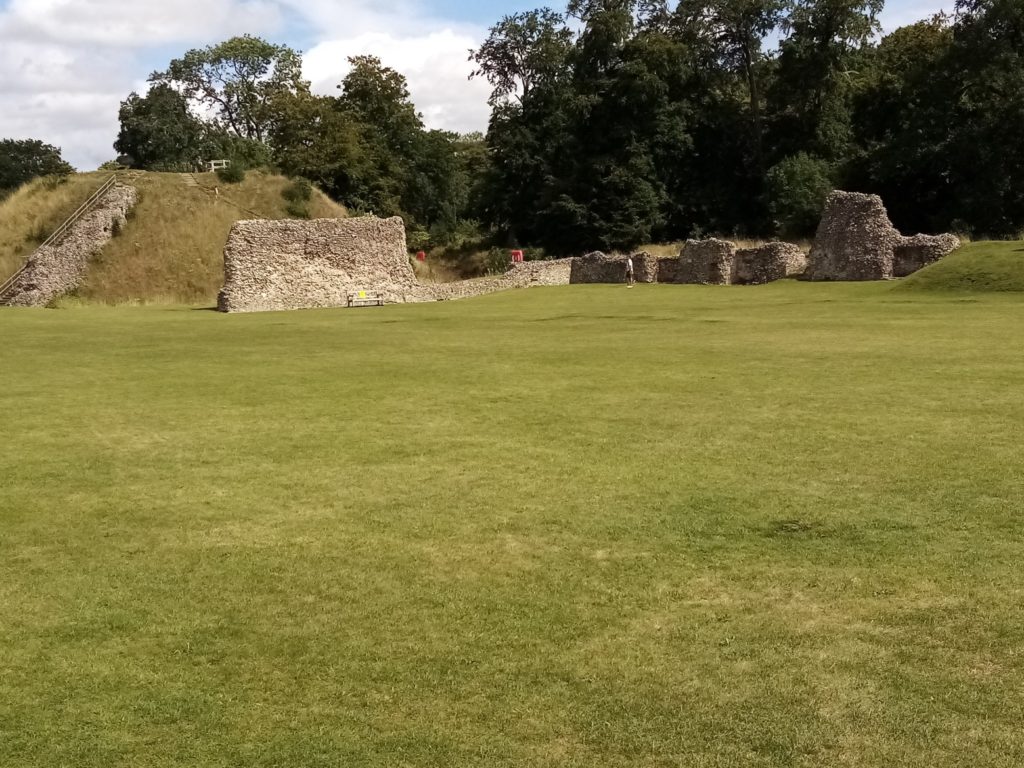

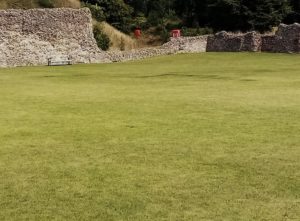 The motte-and-bailey castle was built to control a key route between London and the Midlands during the Norman conquest of England in the 11th century. The castle was besieged in 1216 during the civil war between King John and rebellious barons, who were supported by France. It was finally captured by Prince Louis, the future Louis VIII. It was retaken by royal forces the following year and given to Richard, Earl of Cornwall, beginning a long association with the Earldom of Cornwall and the later duchy. Richard redeveloped the castle as a palatial residence, and made it the centre of the earldom’s administration. Edward III further developed the castle in the 14th century and gave it to his son, Edward, the Black Prince, who expanded the hunting grounds. The castle was also used to hold royal prisoners, including John II of France and rival claimants to the English throne. In the late 15th century, the castle became increasingly unfashionable and fell into decline. By the mid-16th century, it was in ruins and unsuitable for royal use. The castle was almost destroyed during the construction of the London and Birmingham Railway in the 1830s. As a result, it became the first building in Britain to receive statutory protection from Parliament. In 1930, the castle passed from the Duchy of Cornwall to the government. Entrance to the ancient monument is free.
The motte-and-bailey castle was built to control a key route between London and the Midlands during the Norman conquest of England in the 11th century. The castle was besieged in 1216 during the civil war between King John and rebellious barons, who were supported by France. It was finally captured by Prince Louis, the future Louis VIII. It was retaken by royal forces the following year and given to Richard, Earl of Cornwall, beginning a long association with the Earldom of Cornwall and the later duchy. Richard redeveloped the castle as a palatial residence, and made it the centre of the earldom’s administration. Edward III further developed the castle in the 14th century and gave it to his son, Edward, the Black Prince, who expanded the hunting grounds. The castle was also used to hold royal prisoners, including John II of France and rival claimants to the English throne. In the late 15th century, the castle became increasingly unfashionable and fell into decline. By the mid-16th century, it was in ruins and unsuitable for royal use. The castle was almost destroyed during the construction of the London and Birmingham Railway in the 1830s. As a result, it became the first building in Britain to receive statutory protection from Parliament. In 1930, the castle passed from the Duchy of Cornwall to the government. Entrance to the ancient monument is free.
Continue along White Hill, turn right under the railway bridge and cross to the 170-year-old Crystal Palace pub which was designed by Joseph Paxton, who was also responsible for the Crystal Palace which housed the Great Exhibition. It was a favourite canal side haunt until the 1970s when industrial narrow boat trade ceased. Join the Grand Union canal towpath and turn left at the start of nearly two miles of flat, trouble free walking passing The Boat pub and then The Rising Sun. At bridge 143 cross over the canal and continue to bridge 146 (bottom left).
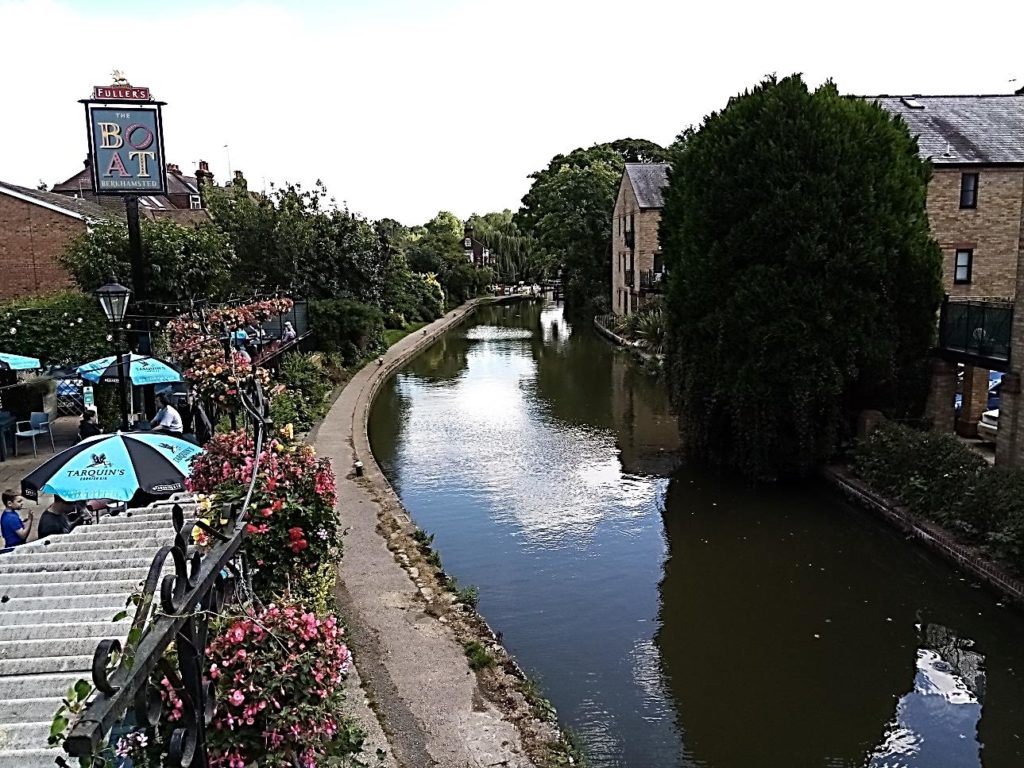
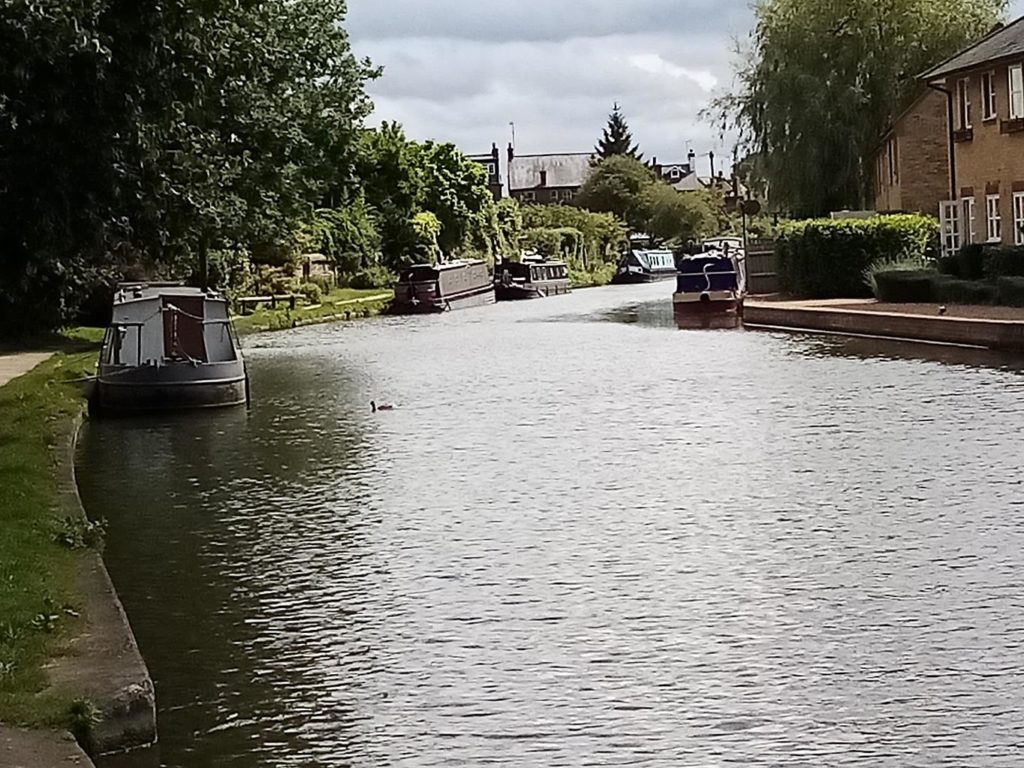
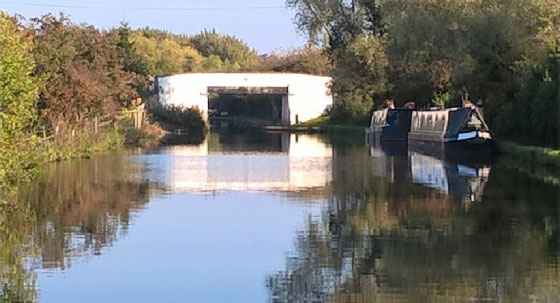
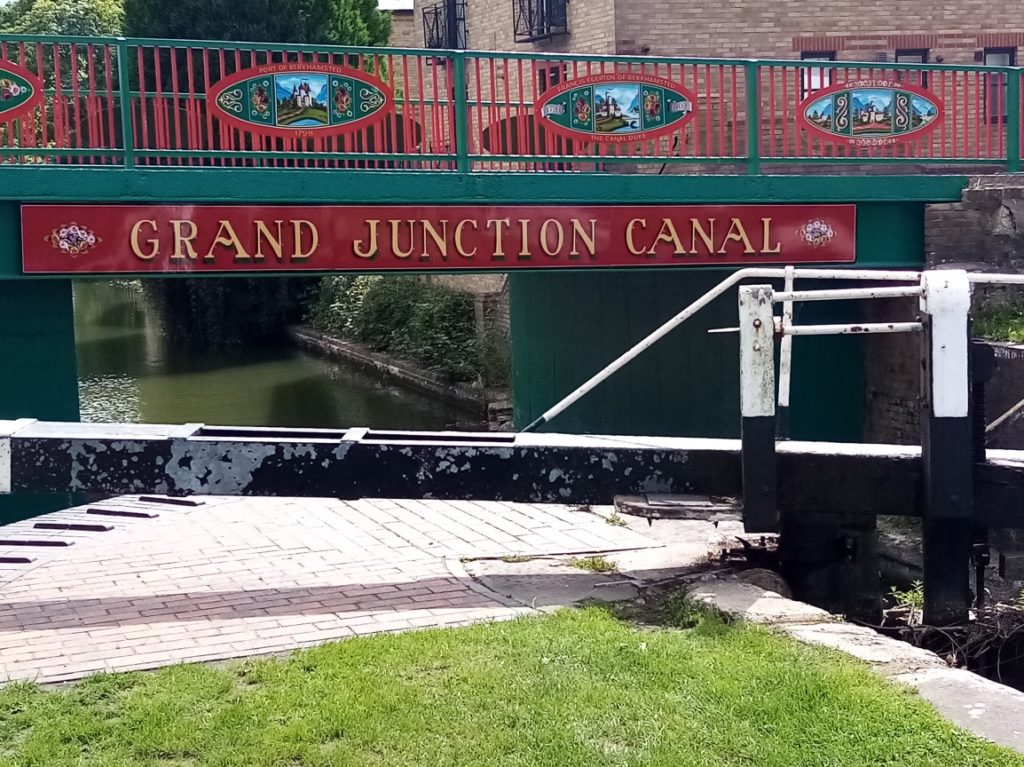
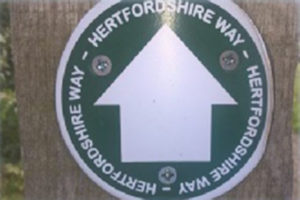 If you have decided to opt for the shortened walk and are heading for Hemel Hempstead station than refer to paragraph 7a in the official guidebook. Paragraph 7b explains out how you can rejoin the Hertfordshire Way at the start of the second day’s walk.
If you have decided to opt for the shortened walk and are heading for Hemel Hempstead station than refer to paragraph 7a in the official guidebook. Paragraph 7b explains out how you can rejoin the Hertfordshire Way at the start of the second day’s walk.
Leave the towpath, climb the path up to Sharpes Lane, turn right and walk to London Road. Turn left, cross the road and walk past the pubs until the village hall on the opposite side of the road when a footpath on your right directs you towards open land, crosses the A41 and enters Little Hay golf course. A signpost points the way, but I followed the right hand edge of the longish grass parallel to the fairway (picture below) for about five minutes until some trees appeared and then a path heading right to the left of the course. Continue ahead. Pass two white bungalows and a large shed and head towards the clubhouse. You don’t need a set of clubs to stop for a drink and a short rest.
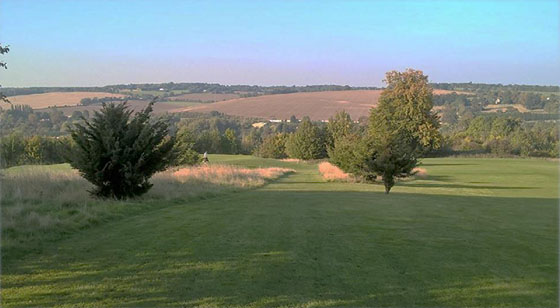
Keep on the road until, just beyond the car park, a footpath on the left dips into the woods. It’ll take you to the Hempstead Road where you turn right and virtually immediately cross the road into Bushfield Road. At the end turn right into Stoney Lane and enter Bovingdon through the impressive churchyard. On your right when you reach Church Street is The Bell pub where I ended my day. On walking in I discovered a blood cousin who I hadn’t seen for a couple of years serving behind the bar. A wonderful excuse to definitely stay put and chat. As I suspected back on Berkhamsted common the remainder of the walk could keep until another day!
You may well be less distracted, less prone to feeble excuses and more resolute so feel free to continue until King’s Langley. I’ll meet you there later.


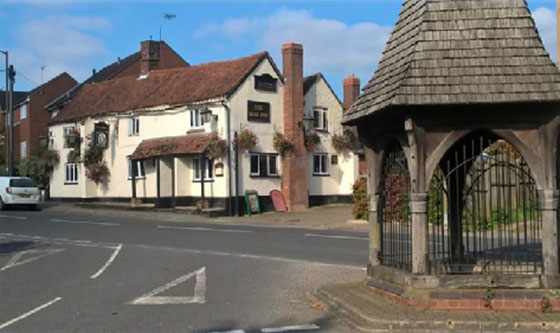 A name for the village first appeared in deeds from 1200 as Bovyndon. It could have originated from the Old English word ‘Bufan dune’ meaning “above the down” or from ‘Bofa’s down’, the down belonging to Bofa. The impressive St Lawrence Church stlawrrencebovingdon.com – which can boast the second largest churchyard in Hertfordshire – was built in 1845, two years after the former neglected building was torn down. The only part of the old church remaining is the lower half of the tower. Nevertheless, it is thought a church or chapel has stood on the site since at least 1200. The distinctive avenue of clipped yew trees were planted in the 1880s – at the same time as farmers were barred from grazing their animals in the churchyard! Bovingdon is medieval in origin but expanded significantly in the 1940s, a time when the neighbouring airfield (off route) played a strategic role in World War II. The airfield was built between 1941/42 when RAF Bomber Command took up residence. Later that year it was handed over to the United States Army Air Forces. With its main runway over a mile long Bovingdon become home to the American Air Force between 1943-63. The Americans flew some combat missions from Bovingdon until the airfield became a training base for B-17 crews until the end of WWII. Several film stars were assigned to the base including Clark Gable, James Stewart and William Holden. Among famous wartime visitors were Bob Hope, Mrs Eleanor Roosevelt and Glenn Miller. Flying ceased at the airfield in 1969 and it shut three years later.
A name for the village first appeared in deeds from 1200 as Bovyndon. It could have originated from the Old English word ‘Bufan dune’ meaning “above the down” or from ‘Bofa’s down’, the down belonging to Bofa. The impressive St Lawrence Church stlawrrencebovingdon.com – which can boast the second largest churchyard in Hertfordshire – was built in 1845, two years after the former neglected building was torn down. The only part of the old church remaining is the lower half of the tower. Nevertheless, it is thought a church or chapel has stood on the site since at least 1200. The distinctive avenue of clipped yew trees were planted in the 1880s – at the same time as farmers were barred from grazing their animals in the churchyard! Bovingdon is medieval in origin but expanded significantly in the 1940s, a time when the neighbouring airfield (off route) played a strategic role in World War II. The airfield was built between 1941/42 when RAF Bomber Command took up residence. Later that year it was handed over to the United States Army Air Forces. With its main runway over a mile long Bovingdon become home to the American Air Force between 1943-63. The Americans flew some combat missions from Bovingdon until the airfield became a training base for B-17 crews until the end of WWII. Several film stars were assigned to the base including Clark Gable, James Stewart and William Holden. Among famous wartime visitors were Bob Hope, Mrs Eleanor Roosevelt and Glenn Miller. Flying ceased at the airfield in 1969 and it shut three years later.
With your back to the Bell Inn turn left past the well house, cross the road and drop down Chipperfield Road to a turning on the right called Austins Mead, a circular cul-de-sac. At the top, squeezed between two houses but well signposted, is the footpath which will take you to Belsize and Chipperfield. The section to Belsize is a series of easily followed paths around the perimeter of, and diagonally across fields (see picture below left), through a number of kissing gates but – courtesy of the trustworthy roundels – difficult to go astray. Eventually you’ll leave the fields by a kissing gate, cross a road and continue into Holly Hedges Lane. Follow the road for half a mile until you come to Holly Hedge Cottage on your left and then enter the thick but welcoming Woodman’s Wood (below top right and bottom left). Where the route bends right go straight on along a signposted path keeping to the left fork and then skirting a field until the path emerges from the trees and drops down into the settlement of Belsize. (bottom right). Turn left into Dunny Lane, cross over and then almost immediately you’ll come to the foot of Windmill Hill which lures you upward via a bridleway into the sumptuous Chipperfield Common.
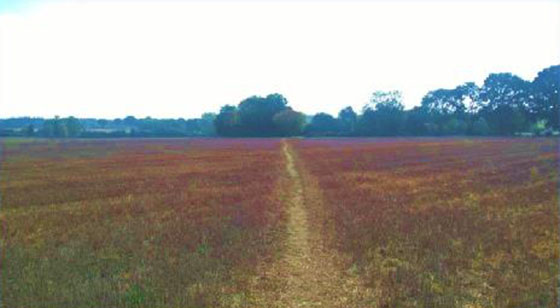

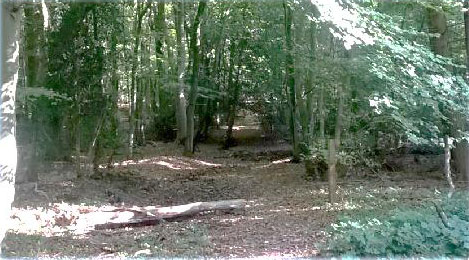
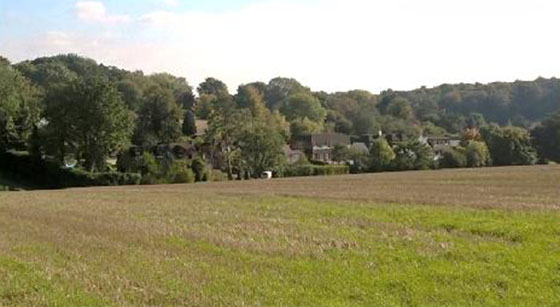

Chipperfield Common (see above and below), which covers 116-117 acres, mostly comprises secondary woodland that has taken over heath land grazed by local people until the 1930s. It was gifted to Hemel Hempstead Rural District Council by the local Blackwell family in 1936 with the proviso the authority should “take great care to consult local feeling so far as the management of The Common is concerned in the future.” The common, which is criss-crossed by a network of easy to follow footpaths, includes five ponds, two early Bronze Age burial mounds and eight veteran Spanish sweet chestnut trees thought to date back to the 1600s and believed to be descended from specimens brought back from Spain in the Middle Ages. The showpiece Apostles Pond (below right) was once a monastery fishpond. Historically twelve beautiful limes graced the pond, until Judas Iscariot was blown down! In the 1980s the original trees were pollarded and 12 new ones planted.


There are many delightful routes across the common but the Hertfordshire Way follows the wide bridleway (see pictures above left) around its right hand edge with some enviable houses for company until you arrive at the Apostles Pond. Look for an iron gate on your right and bear half left along an unclear narrow path which, if you are confident you are on target, follow until you finally emerge from the trees at Top Common on Common Road. Ultimately it doesn’t matter if you lose your way on the common. It’ll only be a short walk either left or right to return you to the correct spot. I think drifting from the supposedly ‘chosen’ route is part of the enjoyment of exploring woodland.

Cross the road and enter the footpath alongside the drive to The Paddock. If there are walkers who have a perverse attraction to – and fondness for – kissing gates the next mile to the A1 will send them into raptures. For the rest of us Hertfordshire County Council’s policy of replacing stiles with kissing gates will have prevented untold groin strains, muscle aches, undignified plummets into brambles and all the other pitfalls associated with clambering over rickety stiles with a rucksack on your back and looming exhaustion in your legs. Stiles threaten one’s dignity. Kissing gates prevent such humiliations. From the road you pass through four kissing gates in quick succession as the land rises and dips slightly alongside hedges, through pastures on obvious routes and then on a broad farm track until another series of kissing gates lead you through fields en route to a footbridge over the A41 (below). I lost count of the number of gates I squeezed through but it was getting near to a dozen and I’m not convinced they were all called for. Perhaps it was a case of the footpath authority mistakenly over-ordering twice as many as were needed and a foreman, reluctant to send them back because of the paperwork, telling his crew: “Stick the extra ones in where there’s a gap. No one will notice.” At the end of the footbridge go left and then right through a kissing gate on to a broad farm track which drops down to King’s Langley emerging between Broadfield Farm and Wayside Farm on the Watford Road. Turn right, cross over and just before reaching the roundabout turn left down a path which descends to the canal. Join the main road uphill until the T-junction with Station Road. The station is on your right. The next stage of the walk is on your left.


For those who completed the 15 miles in an unbroken trek, sore feet notwithstanding, it must have been a rewarding day.
Ever-changing, wonderfully varied, some lovely stopping-off points and almost certainly a true sense of achievement at the end.
For those of us who dawdle, get distracted and are easily seduced by the prospects of a pint, a pub bench and a ponder it engendered the same feelings. It just took a bit longer to reach King’s Langley that’s all. Who’s counting anyway? It’s still a wonderful journey.
Now on to Leg 8 where we reach the southernmost point of the walk en route to Shenley.